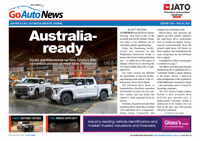Make / Model Search
News - ToyotaToyota aims for zero tolerance on safetySafety first: Some of the technology Toyota has in mind to end accidents. Toyota sets a safety goal of no accidents and no casualties5 Nov 2003 By BRUCE NEWTON TOYOTA Motor Corporation has declared it has the automotive safety goal of zero accidents and casualties. The laudable if highly unlikely target was revealed at a TMC media presentation in Japan at its Higashifuji test centre last month. "The pursuit of vehicle safety to save lives is one of the major missions of an automobile manufacturer," said Tetsuo Hattori, managing director of vehicle engineering. "Toyota will strive to help create a motorised society that has no injuries or accidents in the future."According to Toyota research, more than 70 per cent of accidents involving death or serious injuries are caused by late recognition of the danger, the result of lack of attentiveness. Speed, the revenue-raising drum banged by the police and politicians here, is not even broken out as a cause. Toyota says operation and judgment error trigger 29 per cent of serious accidents. It identifies three key factors that need to be influenced to achieve accident reduction – people, vehicles and the environmentBut at Higashifuji, Toyota concentrated on the vehicle aspect, specifically electronic aids which remove significant vehicle control from the driver. These included:
Mr Hattore said that the driver would remain the "main player" in the car even as new systems took more control. "We feel that the driver should control the vehicle. Drivers are human after all and there are times when they are inattentive, so the vehicle is there to assist," he said. "If we really think this hard, then concept-wise we will become very close to automatic driving. But if you have auto driving then people will pay less and less attention." |
Click to shareToyota articlesResearch Toyota Motor industry news |









Facebook Twitter Instagram